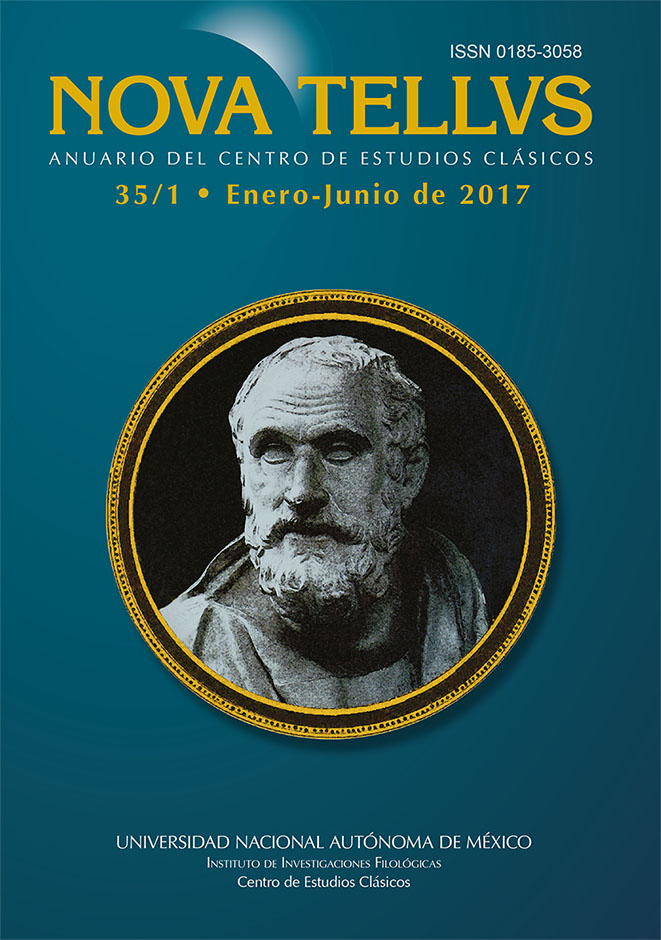Does Ausonius’s Griphus Ternarii Numeri: Rhetorical Game or Gnostic-Neoplatonic Miscellany?
Main Article Content
Abstract
The Griphus Ternarii Numeri, by Decimus Ausonius (c. iv a. C.), is a short poem that it inserts in the spirit of their age, traversed by Gnostic and Neoplatonic currents. From these statements, the objective of the analysis is going to focus on resolving the thematic and ideological boundaries of this rhetorical lusus, consistent with a heterogeneous set of philosophical ideas in which the Neoplatonism participates and that the Christian Church itself can’t avoid to discuss the Trinitarian concept.
Downloads
Metrics
- Usage
- SciELO - Full Text Views: 291
- SciELO - Abstract Views: 40
Article Details
Copyright Notice
The authors who publish in NOVA TELLVS accept the following terms:
- The author or authors commit themselves to sign a Declaration of unpublished text and proprietary rights assignment authorizing the publication in the different platforms and spaces of diffusion of NOVA TELLVS and ceding the proprietary rights on the work in total and exclusive form to the Universidad Nacional Autónoma de México, according to article 84 of the Federal Law of Copyright and others relative and applicable to its regulation, in the understanding that the right of the author over the work will be respected, and the corresponding credit will be granted to them.
- All texts published by NOVA TELLVS—without exception—are distributed under the Creative Commons 4.0 Attribution - Non-Commercial (CC BY-NC 4.0 International), which allows third parties to use what has been published as long as they mention the authorship of the work and specify that the first publication was made in this journal.
- Authors may enter into other independent and additional contractual arrangements for the non-exclusive distribution of the version of the article published in NOVA TELLVS (e.g. including it in an institutional repository or making it known in other paper or electronic media) provided that it clearly and explicitly states that the work was first published in this journal.
- For all of the above, together with their proposed material, authors must submit the Declaration of unpublished text and proprietary rights assignment format of the first publication duly requisitioned and signed by the authors. This format should be sent as a PDF file to novatellus@unam.mx or iiflnovatellus@gmail.com
References
ALSINA CLOTA, J., El neoplatonismo. Síntesis del espiritualismo antiguo, Barcelona, Anthropos, 1989.
AUSONIUS, with an English translation by Hugh G. Evelyn White, in two volumes, London, Heinemann, 1951 [19191].
CAMERON, A., The Last Pagans of Rome, Oxford, Oxford University Press, 2011.
CAMERON, Av., El mundo mediterráneo en la Antigüedad tardía (395-600), Barcelona, Crítica, 1998.
DE GUBERNATIS, A., Mitología zoológica. Las leyendas animales. II Los animales del aire, Palma de Mallorca, Alejandría, 2002.
GIANOTTI, G. F., “I testi nella scuola”, en G. Cavallo, P. Fedeli y A. Giardina (eds.), Lo spazio letterario di Roma Antica, vol. II, Roma, Salerno Editrice, 1989, pp. 421-466.
GREEN, R. P. H., The Works of Ausonius, Oxford, Clarendon Press, 1991.
GRIMAL, P., Diccionario de mitología griega y romana, Barcelona, Paidós, 1984.
HADOT, P., “Etre, vie, pensée chez Plotin et avant Plotin”, en Les sources de Plotin, Tome V, Entretiens sur l’ Antiquité Classique, Genève, “Fondation Hardt”, 1960, pp. 107-157.
KASTER, R., “Servius and idonei auctores”, AJPhil, 99, 1978, pp. 181-209.
MERLAN, Ph., From Platonism to Neoplatonism, Netherlans, Martinus Nijhott, 1968.
MOLINA AYALA, J., Racionalidad y religión en la antigüedad tardía, México, Universidad Nacional Autónoma de México, 2012.
MOMIGLIANO, A., De paganos, judíos y cristianos, México, FCE, 1996.
Pecere, O., “I meccanismi della tradizione testuale”, en G. Cavallo, P. Fedeli y A. Giardina (eds.), Lo spazio letterario di Roma Antica, vol. III, Roma, Salerno Editrice, 1990, pp. 297-386.
PÉGOLO, L., “Ephemeris de Décimo Ausonio: un día en la vida de un aristócrata tardoantiguo”, Actas y comunicaciones del Instituto de Historia Antigua y Medieval, 9, 2013, <http://www.filo.uba.ar/contenidos/investigacion/institutos/
historiaantiguaymedieval/publicaciones.htm>.
PÉGOLO, L., Tensiones literarias e ideológicas en la poesía de Aurelio Prudencio Clemente: el Cathemerinon, Buenos Aires, Facultad de Filosofía y Letras, 2014.
PÉGOLO, L. et al., Cultura y pedagogía en el Tardoantiguo. Claves de lectura sobre los Comentarios de Servio a la Eneida, Buenos Aires, Facultad de Filosofía y Letras, 2010.
QUASTEN, J., Patrología I. Hasta el concilio de Nicea, Madrid, B.A.C., 2001.
REMES, P., Neoplatonism, Stockfield, Acumen, 2008.
SHAW. G., “After aporía: Theurgy in Later Platonism”, en J. Turner y R. Majercik (eds.), Gnosticism and Later Platonism. Themes, Figures, and Texts, Atlanta, SBL symposium series, no. 12, 2000, pp. 57-82.
SIMONETTI, M., La crisi arriana nel IV secolo, Roma, Istituto Patristico Agustinianum, 1975.
SIMONETTI, M., “Hilario de Poitiers y la crisis arriana en Occidente. Polemistas y herejes”, en A. di Berardino y J. Quasten (eds.), Patrología III. La edad de oro de la literatura patrística latina, Madrid, B.A.C., 1986, pp. 38-165.
SIVAN, H., Ausonius of Bordeaux. Genesis of a Gallic Aristocracy, London, Routledge, 1993.
YARBRO COLLINS, A., “Numerical Symbolism in Apocalyptic Literature”, ANRW, Band II, N° 21, vol. 2, 1984, pp. 1221-1287.
Zurutuza , H., “El poder impugnado. El Carmen contra paganos y la era constantiniana”, en H. Zurutuza y H. Botalla (eds.), Centros & márgenes simbólicos del Imperio Romano, Buenos Aires, Facultad de Filosofía y Letras, 2001, pp. 33-59.


